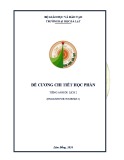
TÀI LIỆU ÔN TẬP
TUYỂN SINH LIÊN THÔNG ĐẠI HỌC KHÓA 07TA
Môn: TỔNG HỢP (Management + Marketing)
GV: Lưu Đức Minh
1

MANAGEMENT
I. THEORETICAL QUESTIONS
1. Present the four basic functions of management?
2. Present the three kinds of managers?
3. Present the basic management skills?
4. Present decision making in the business operation
5. What is SWOT analysis? Why is it necessary for a planning process?
6. Explain the hierarchy of human needs by Maslow?
7. Explain the theory X, Y
8. Present centralisation and decentralisation in an organization
9. What are some communication barriers in the workplace?
10. Identify the main characteristics of the leadership
II. GAP FILL
• GAP FILL 1
Complete the following passage, using suitable forms of the words in the box below
achieve reach report feedback objective
progress performance role stage view
My boss called me into her office to discuss my (1)………………………… during the last six
months. She said that I had made good (2)………………………… and had had no difficulty in
(3)…………………………my goals. She made it clear that she was going to give me a good
(4)…………………………
I suppose I should have been grateful to her. However, one thing bothered me. I wondered why she
didn’t ask me what I felt about the job. Why didn’t she get some (5)…………………………
from me? I thought that was one of the main (6)………………………… of the interview.
Since my (7)………………………… was obviously to sit quietly and say nothing, I did just that. At
this (8)………………………… of my career, I can’t afford to upset my boss. But if I ever
(9)………………………… her position, I shall handle these interviews differently. In my
(10)…………………………, it’s vital to listen to employees.
• GAP FILL 2
Which of these terms are defined below?
subordinates shortlist job security strike headhunters
functional organization motivate personnel autonomy line authority
1) ……………………………: a group of applicants selected for an interview
2) ……………………………: a system in which decision-making passes from the top to the bottom of a
hierarchy, as in the army, for example
2

3) ……………………………: a way of dividing a company into separate departments, depending on the
tasks they carry out
4) ……………………………: an organization’s staff or work force; the people it employs
5) ……………………………: an organized refusal to work by a group of employees, in the attempt to
achieve better pay or working conditions, or to protest about something
6) ……………………………: employees under someone else’s authority or control
7) ……………………………: freedom to determine one’s own behavior and actions
8) ……………………………: people who attempt to engage senior managers and executives for job
vacancies by attracting them from other companies
9) ……………………………: the extent to which a job can be considered as permanent
10) ……………………………: to give an incentive to someone, to encourage
• GAP FILL 3
Complete the following sentences using suitable forms of the words from the box below.
authorise authority control function autonomy
innovate innovative delegate delegation initiative
initially unemployable employment indecisive undecided
1) In many department store groups, buying and finance are two ……………………… which are
handled by Head Office.
2) Managers who like power find it difficult to ……………………… responsibility.
3) To stay competitive, high technology firms must constantly ………………………, or else their
products become out of date.
4) When you delegate authority in a business, you lose a degree of ……………………… over certain
functions.
5) In some multinational organisations, subsidiaries are given a great deal of ……………………… –
they rarely have to consult Head Office.
6) ……………………… firms often make the mistake of not concentrating enough on marketing.
7) In our factory, the General Manager is ……………………… to spend up to £1000 a month on repairs
and maintenance.
8) I like my staff to make decisions for themselves, but they seem afraid to show any ………………….
9) He’s fairly old and hasn’t had a job for years. I’d say he’s virtually ……………………….
10) Because we were ………………………, we wasted time and lost the contract.
• GAP FILL 4
Complete the following passage, using suitable words the box below.
market major image creative job security
finance lack drawback professional personnel
coming up segment underestimate expertise ensure
growth delegate trust under price exclusive
The problems of small high-tech firms have attracted a lot of attention recently. Research show that
many of these firms are set up by talented, (1)…………………………… scientists, their owners have
3

to trouble (2)…………………………… with innovative products but they often can’t build on their
early success.
One reason for this is that they don’t have much management (3)…………………………….
Therefore, they are unable to develop the strategies which are necessary for their company’s
(4)……………………………. They are in a rush to develop products and don’t think enough about
how to (5)…………………………… them. When they do try to sell their products, they spend too
much time trying to gain the (6)…………………………… of potential customers. Another mistake
they make is to (7)…………………………… their products so that they have no
(8)…………………………… for future development. Once the firms begin to grow, their owners
(9)…………………………… the future costs of developing and marketing new products.
(10)…………………………… of financial planning is a (11)…………………………… weakness of
such companies. It is difficult for the high-tech firm to attract the right (12)……………………………
because it cannot offer the same (13)…………………………… as a large organization.
The high-tech firms can get round some of the problems by developing a specialist
(14)……………………………. It can aim at a particular (15)…………………………… of the
market. Customers then start seeking out the firm, so its marketing costs are reduced. The only
(16)…………………………… is that it may take some time before customers accept the firm’s new
technology.
As soon as the high-tech business has reached a certain size, it will be a good idea to bring in
(17)…………………………… management. The founder of the firm can then
(18)…………………………… responsibility for activities like marketing and finance. If a high-tech
firm needs money very badly, it may arrange a link-up with a large company. It will offer that
company (19)…………………………… rights to its technology.
Enthusiasm, bright ideas, venture capital and technology are not enough to
(20)…………………………… success. Basic management skills – especially financial and
marketing ones – are also vital.
• GAP FILL 5
Choose the best word to fill in the blanks in the following passage:
orders motivate decisions delegate measure
activities dealing with strategies objectives information
Aphrodite Cosmetics
Managing Director
As a world leader in the health and beauty sector. Aphrodite is a multinational company with a
turnover in excess of £5bn. We are seeking a Managing Director of outstanding abilities to take us into
the next decade and beyond.
The Role
The successful candidate will be required to:
• set …………… and communicate them clearly to staff.
• develop …………… which will increase profitability and market share.
4

• take …………… at the highest level affecting both the long and short term activities of the
group.
• accurately …………… performance both of individuals and departments.
• issue …………… which may sometimes be unpopular.
The Person
We are looking for someone who is:
• strong, charismatic and who can …………… staff by his / her vision.
• well – organized and who can co – ordinate the …………… of the whole group effectively.
• calm when …………… a crisis.
• able to …………… tasks to others when necessary.
• able to communicate …………… clearly and precisely to all levels of the company.
• GAP FILL 6
Choose the best word to fill in the blanks in the following passage:
solve vision performance gains make
creating communicate relationship achieve authority
Leadership
Without followers, there would be no leaders. The concept of leadership and the qualities needed for
someone to become a leader, can probably best be understood by studying the (1)……………… between the
leader and his or her followers.
Good leaders have empathy – the ability to step into someone else’s shoes – because they are good
listeners. They are open, always willing to discuss and (2)……………… problems.
Team-building is one of the top priorities of effective leaders. They work at (3)……………… an
environment in which each team member, while contributing to the team effort and to the purpose of the
organization, is able to improve on their own (4) ………………
Indeed, they are very good at empowering their staff, enabling each of them to become a creative and
independent team player. This way, every individual (5) ……………… the confidence and ability to (6)
……………… the kind of decisions which will help the company (7) ……………… its long-term goals,
Good leaders are also inclusive, they like to involve everyone – and they understand the importance of
delegating (8) ………………
Finally, they have more than just targets: they have a (9)……………… They can see clearly where
they would like the company to be in five or ten years’ time, and they are able to (10) ……………… this to
their employees.
• GAP FILL 7
Choose one suitable word to fill into each gap in the extract. Mark your answer by writing the numbers
in the blanks before the words in the box.
____ analytical ____ objectives ____ subordinates ____ motivate ____ richer
____ measurement ____ resources ____ develop ____ organize ____ team
5









![Đề cương chi tiết Tiếng Anh thương mại 2 (Business English 2) - Trường ĐH Đà Lạt [Mới nhất]](https://cdn.tailieu.vn/images/document/thumbnail/2025/20250212/tuetuebinhan666/135x160/7211739332500.jpg)




![Trắc nghiệm Tiếng Anh kinh doanh: Bài test chuẩn và [từ mô tả phù hợp]](https://cdn.tailieu.vn/images/document/thumbnail/2025/20251102/ngocanhn201@gmail.com/135x160/51201762135116.jpg)









![Đề cương ôn tập Tiếng Anh du lịch (English for Tourism) [mới nhất]](https://cdn.tailieu.vn/images/document/thumbnail/2025/20250728/kimphuong1001/135x160/55271753673317.jpg)

